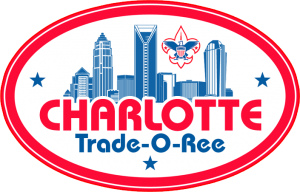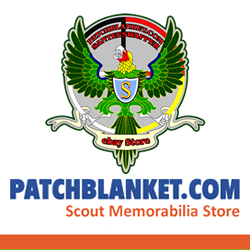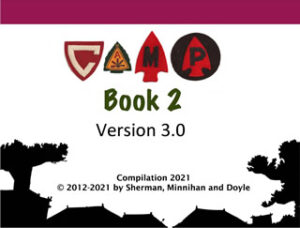Boy Scout Council Shoulder Patch Sorting And Cataloging
When you have almost 2,000 council shoulder patches sorted out alphabetically on a table that’s a great time to film a video! But what would make this video interesting is instead use that as a backdrop to walk through the history of cataloging shoulder patches. I start with Bill Price books, move through Prince Watkins books and basically just cover the history of reference books in this niche. Along the way I drop some opinions on how OA collectors catalog their patches differently. Maybe my favorite part of the video is using the Delman books to show how many CSPs have some wonderful designs and meaning that not many of us know about.
After publishing this video I began to correspond with Tom Jones who was an author on the predecessor to the current Council Shoulder Insignia Guide. He shared some background information that I thought was wonderful. I am posting it here.
I had decided to collect CSPs while staffing Philmont in 1977. I don’t remember where I got my council list, but during my drive from New Orleans to Philmont I stopped at 9 different council offices to pick up patches to trade. These were the days when CSPs were basically available just through the council issuing (although the New York Scout Shop may have already been selling CSPs unknown to me). It was a couple years before National started listing them in their national catalogue.) The major reference book you didn’t mention was Arapaho I, History of Scouting through Insignia (Breithaupt and Hoogeveen 1976). It was on sale at the Seton Museum at Philmont during the summer of 1977. Unlike the Pete Smith, Bill Price books (as I remember), Arapaho tried to picture every CSP issued, had a standard method of numbering based on order of issue and a standardized way of describing the issues. In the introduction they set forth fairly clear guidelines on what was an issue as opposed to a variety.
I also remember using the small ITA booklet in the late 70’s. Since CSPs were new (and councils had not figured out that they could gouge collectors) new issues were rare, everything was listed to give you something to collect. When I go back to original twill patches in my collection its not unusual to see 8 or 9 different varieties of the same issue. Not only differences in patch size and thread color, but backing changes, color of thread used to sew on the border, twill direction and roughness all were listed. Kirk Doan continued this and I believe added values on his patch listing.
The first I remember seeing CSP values other than price realized lists was when Bob Cylkowski on the request of SCQ published a listing of values of early (mostly 1st issue CSPs). This was around the late 70’s or early 80’s. As noted before Kirk Doan had values listed in his book. Ray Mitchell had a listing of values in the mid 80’s. (Ray died at 52 years age…the same age Prince Watkins died probably within a year of Prince Watkins death.) After Ray’s death Dottie Sovers took over his list I believe. (Ray and Dottie’s guide was not widely distributed and Dottie died late 80’s? I never had George Sover’s listing.)
SCQ still published a new CSP listing (Watkins to Kelton to Amster to Austin I may have left some out), but there was no up to date guide on CSPs in the late 80’s…and CSP collecting was falling by the wayside.
By the 1988 or 1989 Dallas TOR, I had used my fairly new computer to consolidate the data I had from published sources and price realized into a list of values for personal use. At the same time David Franck, Don Hooks, and Jim Ellis had made a standardized listing of all known issues (and main varieties). Unlike me they were planning to publish. Tto get rid of any possible competition they asked me to join them. After much correspondence and a few meetings, our first CSP book was ready by the next Dallas TOR. As to the name: I proposed a number of preCSP CSPs for inclusion, which were not acceptable to the other editors. The compromise was the word “selected” in our title. (A few years later when suggested by Bill Lobelle these were squeezed into the list.)
From the beginning Dave and Don’s listing intentionally ignored backing, twill directions except in some traditionally valued first issues. Over times as the list became longer intentional efforts were made to weed out issues and varieties involving small size differences and especially any reference to color such as darker, lighter, etc (these became color varieties exist or some such words). Any difference which could not be described so a patch could be identified w/o comparing to a different variety was not considered significant.
The first edition of our CSP listing came out in four editions. (As I remember (I may have this wrong): South Central Region CSPs, National just regular issues, National all issues, National all issues including prices in the back). The price listing section was in the back initially, so collectors interested in trading weren’t tempted to make the $’s come out equal. The only guide which sold extensively was the one with price guide, so after the first year that was the only one produced. This book was published every year for the next 20 years and released for the Dallas TOR. We then sold the rights to ISCA.
Over the years changes were made such as: moving price information to be next to the description (everyone wanted it there), marking new listings for the current edition, marking FOS patches, etc.
As for prices: I provided the original data and then had little input on them. Originally it was based on prices realized, but over time prices were quoted as this patch is worth such and such. We instituted ranges to try to address this. Over time prices got unrealistic especially with a decision to standardize values based on quantity produced (while ignoring demand determined by a large number of variables such as: did some get sewn on uniforms; how many collectors are in the council; how many issues had the council produced; was it FOS; intentional short runs…) One of my victories was having FOS prices moved to the description…not just assuming since it was available through the council at $250 that it was worth 250 (when the extra were available at $3 each).
I really liked your suggestion about only collecting CSPs made for regular uniform wear. Our CSP guide introduced TA and SA notations not to tell collectors what to collect but to give some choice on this. A lot of us obsessive compulsives never felt comfortable if there was an empty box. I went ahead and attached a letter I wrote to SCQ summer 1980 (I was a medical resident and pretty poor)
As far as the origin of SAPs in general. I have this insider information. Jerry Stevens (a professional who died last spring) was my professional in BR in the early 70’s and later the council exec at Evangeline Area Council. He had started at South Plains Council (Lubbock) and had designed their first CSP. He recalled that South Plains wanted to encourage some activity (whether SOR or recruiting he didn’t remember) so they made a yellow border patch at the same time as their first regular issue. “We wanted everyone to do the activity, so we decided our first regular issue should have an ugly brown border.” This and the adjacent Buffalo Trails Council (Midland) special yellow bdr at about the same time were probably the first special border colors. When Jerry arrived at Istrouma Area Council he introduced the gld/m bdr Istrouma recruiting patch 1978. It wasn’t long after that that all heck broke loose.
Tom Jones
Comments
Yes there is! I believe the most recent copy was 2017 or 2018. The CSI Guide is now “owned” by ISCA and is available to members digitally on their website. I don’t believe there is a printed version any longer.
Hi, I found your site as I was digging through the internet , trying to find a value guide for CSP’s. Does one exist and how do I get a copy ?
Yours in scouting,
Brian
So the CSI Guide (available to members who join ISCA) has pricing guidance in the back of the book but it’s not accurate. Their website is http://www.scouttrader.org. I always suggest looking at comparable sold listings in the last 90 days on eBay to see what the true going rate is. Don’t look at what people are “asking” for things on eBay but rather what they are selling for. Just my 2 cents.








 Camp Director, Eagle Scout, Order of the Arrow Vigil Honor Member and past Chief, lifelong Scouter and patch collector.
Camp Director, Eagle Scout, Order of the Arrow Vigil Honor Member and past Chief, lifelong Scouter and patch collector.
The last book that I have is the 2002 An aid to collecting selected council shoulder insignia guide book by Tom Jones with Dave and Don Hook? I was wondering if they have some updated books. I also tried to get a hold of the Delman’s. The latest book of color pictures of csp and their history I have is the 2002 book of the 3 911 csp of NY., Penn. & National Capital council in Washington, D.C.